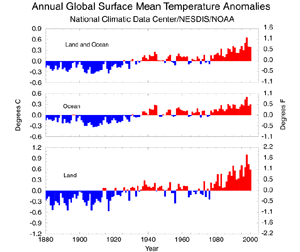|
|
| Global temperatures in 2000 were 0.39C (0.7F) above the
long-term (1880-1999) average*, the sixth warmest year on record
(see graph above). The only years warmer were 1998, 1997, 1995, 1990
and 1999. Land temperatures were 0.59C (1.1F) above average and
ocean temperatures 0.30C (0.5F) above the 1880-1999 mean. A strong
La Nina at the beginning of 2000 weakened during July and August,
but was still evident at year's end. Cooler than normal temperatures
throughout the eastern equatorial Pacific held down temperatures in
the tropics. But temperatures in the non-tropical Northern
Hemisphere continued to average near record levels. Temperatures
north of 20N were the third warmest on record, 0.69C above average.
Annual anomalies in excess of 1.0C (1.8F) were widespread across
Canada, Scandinavia, and much of Eastern Europe and the Balkans.
*The 1880-1999 average combined land and ocean annual temperature is 13.9C (56.9F), the annually averaged land temperature for the same period is 8.5F (47.3F), and the long-term annually averaged sea surface temperature is 16.1C (60.9F). |
 Temperature Trends
Temperature Trends
| During the past century, global surface temperatures have increased at a rate near 0.6C/Century (1.1F/Century), but this trend increased to a rate approaching 0.2C/Decade (0.36F/Decade) during the past 25 years. There have been two sustained periods of warming, one beginning around 1910 and ending around 1945, and the most recent beginning about 1976. Temperatures during the latter period of warming have increased at a rate comparable to the rates of warming projected to occur during the next Century with continued increases of anthropogenic greenhouse gases. |
| Satellite measurements of lower tropospheric temperatures (the lowest 8 kilometers of the Earth's atmosphere) collected since 1979 also indicate warming, but not to the extent shown by surface observations. The adjacent figure shows annual anomalies for both the surface and lower tropospheric temperatures from 1979 to 2000. (Satellite measurements of lower tropospheric temperatures are collected by NOAA's TIROS-N polar-orbiting satellites via the Microwave Sounding Unit (MSU) and adjusted for time-dependent biases by NASA and the Global Hydrology and Climate Center at the University of Alabama in Huntsville). | 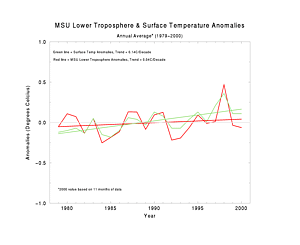 |
| While lower tropospheric
temperatures as measured by the MSU indicate an increase of
0.04C/Decade (0.07F/Decade), surface temperatures have increased at
a rate of 0.14C/Decade (0.25F/Decade). However, measurements of
lower tropospheric (850 millibar to 300 millibar layer) temperatures
collected from instrumented ballons (radiosondes) since 1958*
indicate a rate of warming very similar to that shown by surface
temperature measurements. The figure to the right shows annual
anomalies for both lower tropospheric and surface temperature
measurements since 1958 and the corresponding trend lines.
Temperature measurements of the lower troposphere indicate an
increase of 0.09C/Decade (0.16F/Decade) while surface temperatures
have increased at a rate of 0.10C/Decade (0.18F/Decade).
*Data set developed by Jim Angell of NOAA's Air Resources Laboratory |
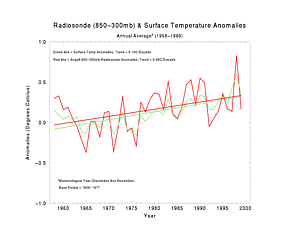 |
 Regional Temperatures
Regional Temperatures
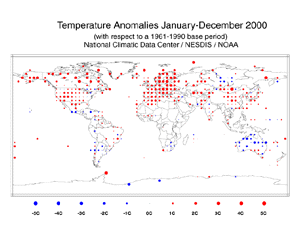 |
Annual temperature anomalies reflect this warming throughout much of the globe. As shown in the adjacent figure, temperatures were more than 1-2C above the 1961-1990 average throughout Canada, Scandinavia, Eastern Europe and the Balkans. A prolonged heat wave gripped much of southern Europe during June and July and claimed many lives across the region as temperatures exceeded 43C (110F) across much of Turkey, Greece, Italy, Romania and Bulgaria. Temperatures in Canada are expected to be more than 1C above normal, the sixth warmest year on record, while Japan is expected to record its fifth warmest year since records began 105 years ago. |
| The only widespread area of below normal temperatures was in Australia. The first six to seven months of 2000 were abnormally cool across much of the continent, but unusual warmth developed in August and continued into the Southern Hemisphere spring. Although temperatures averaged more than 5C (9F) above normal across a large part of central and eastern Australia during the 2000 summer Olympics, annual temperatures are expected to be below average in Australia for the first time since 1984. |
 Global Precipitation
Global Precipitation
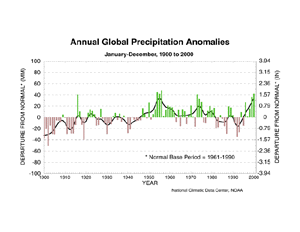
|
Globally averaged precipitation was above average in 2000. Although many areas of the world experienced devastating drought in 2000, for the globe as a whole, 2000 was the 3rd wettest year on record, 41.9mm (1.65 inches) above normal. Precipitation patterns throughout the Tropics were dominated by La Nina throughout much of the year. Indonesia, the tropical Indian Ocean and the western tropical Pacific all experienced greatly enhanced precipitation during the period, while the central tropical Pacific experienced virtually no rainfall at all. Other regions influenced by La Nina included northeast South America and southern Africa, which experienced enhanced precipitation. Conversely, La Nina contributed to below-normal precipitation over equatorial east Africa and along the Gulf Coast of the United States. |
| Heavy rain led to flooding in Columbia from June to August, the Southern Alps were severely affected by heavy rains in October, and monsoon flooding led to great loss of life in India, Bangladesh and the Southeast Asian countries of Thailand, Laos and Vietnam in 2000. In Central America, mudslides brought on by torrential rains killed thirteen people in Guatemala, and Rama City, Nicaragua was flooded in June when heavy rains caused the Rama River to overflow. Several strong Cyclones (Eline, Gloria and Hudah) also caused severe flooding and widespread devastation in Madagascar, Mozambique and parts of Southern Africa. Conversely, severe drought plagued parts of the Middle East, central Asia and southeastern Europe in 2000. The most devastating drought occurred in the countries of Iraq, Afghanistan and Iran where the worst drought in more than 30 years destroyed crops and killed livestock. The summer heat wave and lack of precipitation in southern Europe led to more than 1000 wildfires in Bulgaria that destroyed homes and consumed 125,000 hectares. One-fifth of the island of Samos, Greece was consumed by fire brought on by excessive heat and drought, and one of the worst wildfire seasons in fifty years destroyed more than 7.3 million acres of forest and grasslands in southern and western regions of the United States. |

NOAA's National Climatic Data Center is the world's largest active archive of weather data. The preliminary temperature and precipitation rankings are available from the center by calling: 828-271-4800.
NOAA works closely with the academic and science communities on climate-related research projects to increase the understanding of El Niņo and improve forecasting techniques. NOAA's Climate Prediction Center monitors, analyzes and predicts climate events ranging from weeks to seasons for the nation. NOAA also operates the network of data buoys and satellites that provide vital information about the ocean waters, and initiates research projects to improve future climate forecasts.

For further information, contact:
NOAA/National Climatic Data Center
151 Patton Avenue
Asheville, NC 28801-5001
fax: 828-271-4750
email: Jay.Lawrimore@noaa.gov
-or-
NOAA/National Climatic Data Center
151 Patton Avenue
Asheville, NC 28801-5001
fax: 828-271-4499
email: Tom.Ross@noaa.gov
-or-
NOAA/National Climatic Data Center
151 Patton Avenue
Asheville, NC 28801-5001
fax: 828-271-4040
email: Roger.Winchell@noaa.gov
 NCDC / Climate
Monitoring / Climate
Research / Climate
of 2000 / Search / Help
NCDC / Climate
Monitoring / Climate
Research / Climate
of 2000 / Search / Help
http://www.ncdc.noaa.gov/ol/climate/research/2000/ann/annual2000.html
Last Updated 12 January 2001 by Tom Ross mailto:%20Tom.Ross@noaa.gov and Roger Winchell mailto:%20Roger.Winchell@noaa.gov


